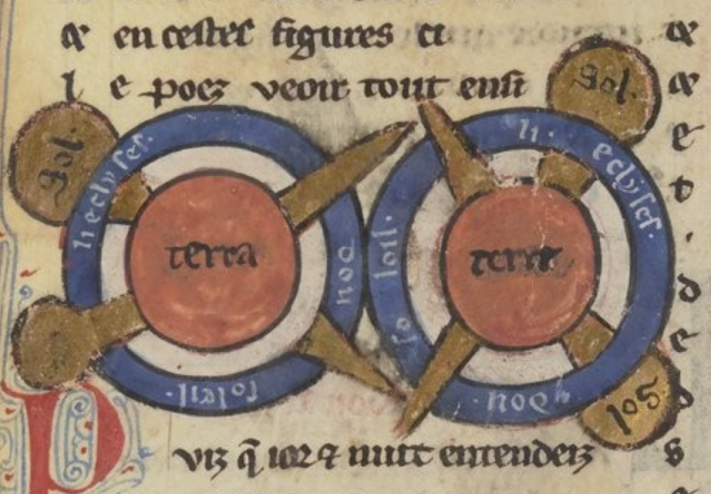
Team 5 will transcribe the version housed at the Bibliothèque Nationale de France, fonds français 24428, ff. 1r-48r
For Phase I of the Image du Monde Challenge (September 25- October 9, 2020) teams will transcribe from the beginning of the work to Book 2, Chapter 4. In the BNF fonds français 24428, the text begins at f. 1r, line 1, and ends at 21v column 1, line 29.
TEAM 5 DOCUMENTS
TEAM 5 UPDATES
OCTOBER 8
Stephanie J. Lahey
As a result of various family and personal emergencies, Team 5 found itself short-handed during the last week of the Challenge! Nonetheless, we powered through. With our manuscript transcribed, our transcription revised, and our transcription statement straightened away, we now settle in to tackle the final stages of the editing process. Off we head towards the finish line!
OCTOBER 4
Matt Westerby
One of the joys of the Image du Monde Challenge is looking beyond my own little slice of the world and making new connections (and cat friends). As I work, however, I am struck by how these manuscripts embody their own little hidden worlds—concealed in texts, in maps, and in the materials that make up the book.
As my fingers jumped across my keyboard, one word sprang out from folio 12v: mouche (fly). What is Gossuin going on about here? A quick Google Books search with the line ending (“une mouche iroit”) shows how these words buzz around the collective imagination. What Gossuin is saying, very roughly, is “as a fly would walk around an apple” (comme une mouche iroit / entour une pome reonde), two men walking in opposite directions from the same point would meet on the other side of the earth. What a vivid image! In a chapter “Middle Age of the Globe,” Alfred Hiatt cites this line as evidence of a thirteenth-century “fantasy of circumnavigation” (Conceptualizing the World: An Exploration across Disciplines, edited by Helge Jordheim and Erling Sandmo, 2019, p. 264). In fact, later editions based on Gossuin’s work illustrate this precise passage (the two men walking that is—not the fly), as in Caxton’s incunable of 1490.
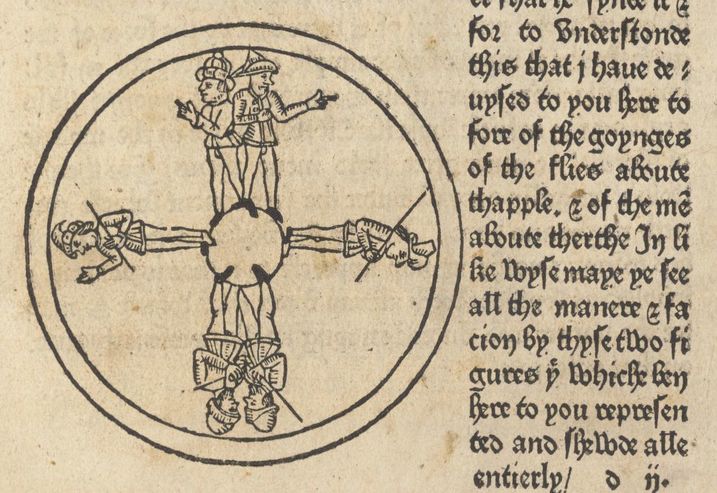
There is no comparable illustration in our manuscript, but keeping the mouche in mind, it’s remarkable how this book can show the unknown through the materials at hand. First, the image described in the text. We’ve all seen flies walking around a piece of fruit! Second, the illustration of the earth and firmament on the recto of this same folio. Here is a 7-line microcosm with the earth inscribed “T(er)re” on what appears to be red bole (an orange-brown iron earth or “terre rouge,” also called gilder’s red clay). Red bole was used by illuminators to build up the tonality and luster of gilded pages. On this folio, it was probably applied first, filling the entire roundel and serving as a ground. The white, blue, red, and gold (probably shell gold in this case) would then have been painted over it.
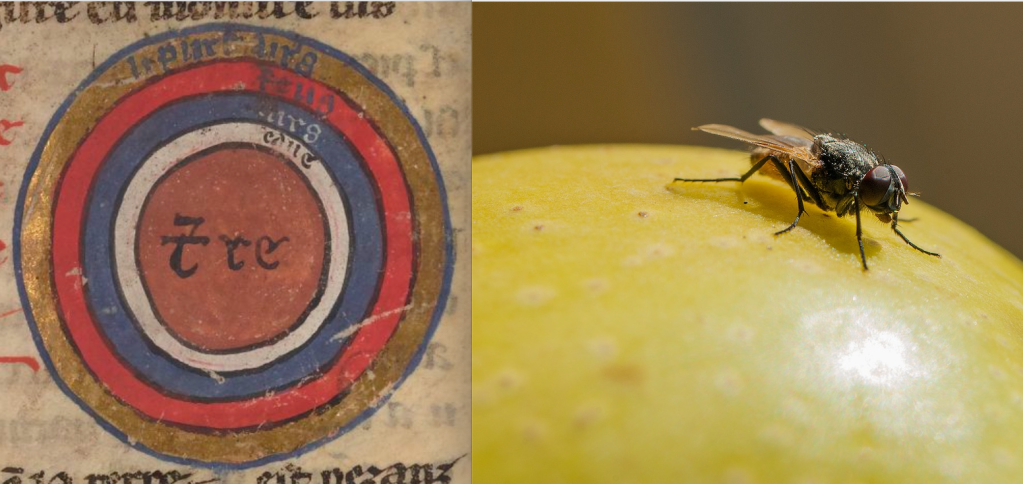
What does the user-reader-viewer think of these materials? Would the exposed bole evoke the red clay of the earth underfoot? If a fly were to land on the edge of this microcosmic image, does it perform some semblance of Goussin’s “round apple” metaphor?
TLDR; mouche ado about nothing, perhaps. So, back to transcribing. After a quick snack of apple slices.
Photo of fly on apple is free for use, no attribution required.
OCTOBER 3
Stephanie J. Lahey
Team 5 had a peculiar start. Amidst the excitement of recruitment and set-up, as we finalized our roster, a pre-launch complication emerged. Initially, our assigned manuscript was Bibliothèque nationale de France, MS Français 1553; we were slated to transcribe ff. 163r–180r.
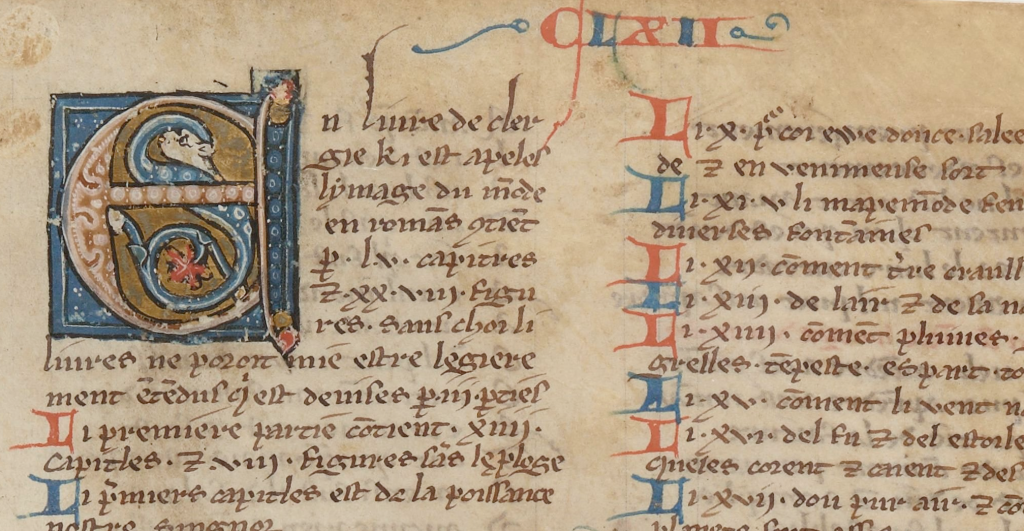
Just prior to the start of the Challenge, however, we learned that Fr. 1553 had been the focus of a third-party project—a transcription already existed (though it had not been made public). As Team 5 co-captain Kathy Krause observed, why re-transcribe a newly-transcribed witness “when we could add to the sum of transcriptions instead”?
Off we set on a hunt for a replacement! Viable witnesses needed to not only contain the first verse redaction, but be both digitized in full and IIIF-friendly.
Fortunately, Arlima provides an extensive bibliography, including a list of first redaction manuscripts. After a bit of searching and back-channel discussion, we identified our new manuscript: Bibliothèque nationale de France, MS Français 24428.
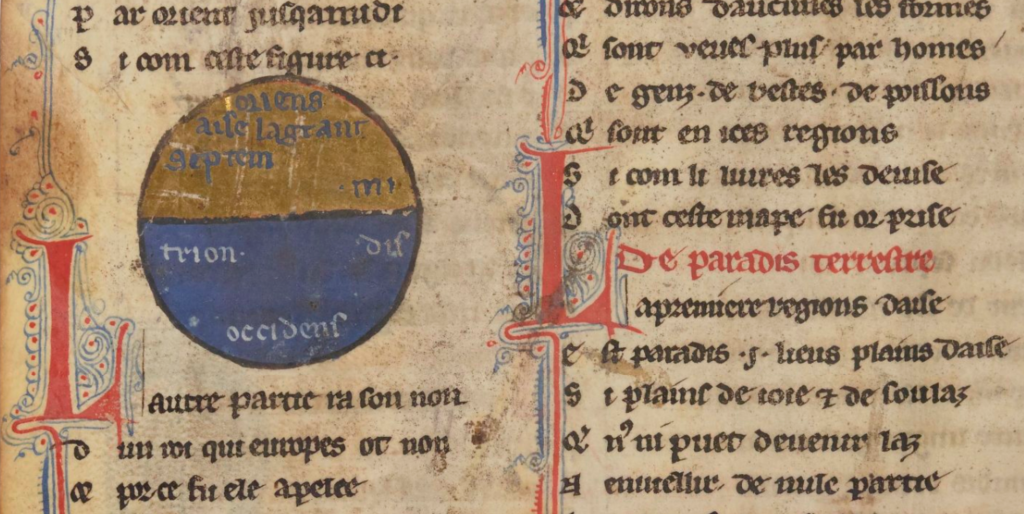
Fr. 1553’s preexisting transcription was brought to our attention during the search for Image du Monde judges, when many of us reached out to colleagues beyond social media. If nothing else, our eleventh-hour adventure demonstrated the value of maintaining extended networks of scholarly contacts.
With a brand new, yet-to-be-transcribed manuscript lined up—and our Slack channels, Google spreadsheets, and other assorted paraphernalia straightened away—we were finally ready to start transcribing. Onward to the Challenge!
#TEAM5 members include:
- Kathy Krause, Co-captain (@kcmedieval), University of Missouri–Kansas City (@UMKC)
- Stephanie J. Lahey, Co-captain (@SJLahey), University of Victoria (@UVic)
- Matt Westerby (@qwesterby), CASVA, National Gallery of Art (@NGADC)
- Alvionne Karpinski (@BiblioCrime), University of British Columbia iSchool (@UBCiSchool)
- Caitlin Postal (@goingpostale), University of Washington (@UW)
- Anna M. Kłosowska, Miami University (@MiamiUniversity)
- Robert Clark, Kansas State University (@KState)
- Maria M. Olson, Emporia State University (@EmporiaState)
- Eric Ensley (@Bookish_Eric), Yale University (@Yale)
- Stacey R. Graham (@StaceyRGraham), Middle Tennessee State University (@MTSU)
